July Meeting Cancelled
The July Board Meeting has been cancelled. The meeting will be rescheduled for later in the month.
The July Board Meeting has been cancelled. The meeting will be rescheduled for later in the month.
Bilma PUD’s Operator, H2O Innovation, will be transitioning its billing software provider over the next few months. The new billing software provider is Starnik and the new website to make online payments is https://h2o.starnik.net
Customers will receive new account numbers and if you are currently enrolled in auto-pay, you will be required to register and make a manual payment for your bill due on June 20. Auto-pay will then go into effect on the next billing cycle.
Customers will receive their new account numbers and information to set up their new online account in the following forms:
For more information, please review the letter below from H2O Innovation or contact H2O Innovation’s customer care team at 281-353-9756.
Dear District Resident,
The District, through its garbage and recycling service provider, is hosting a free event on Saturday, March 23 from 10 a.m. to noon for residents to recycle their electronic waste.
In addition, free document shredding services will also be provided from 10 a.m. to 1 p.m. All paper materials are accepted and staples, paper clips, and binder clips do not need to be removed.
The event will be held at the Spring Creek Oaks Clubhouse #2 at 6002 Bur Oak Drive, Spring, Texas, 77379 in the parking lot nearest the tennis courts.
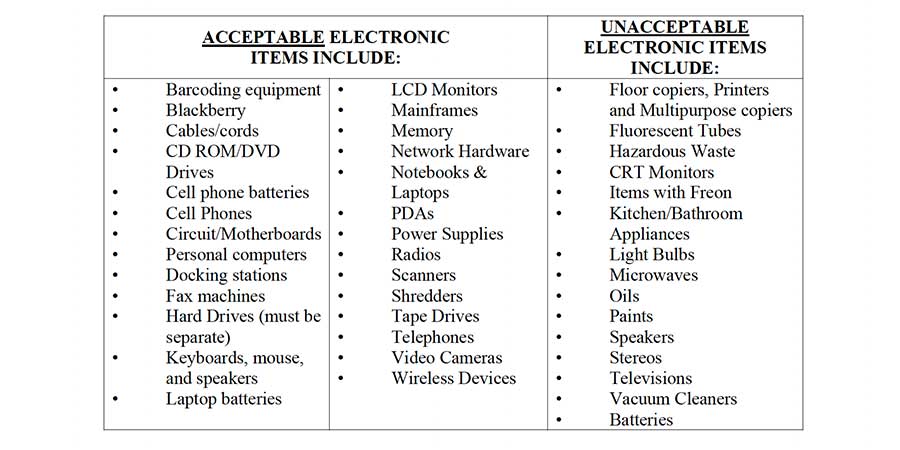
Thank you,
Bilma PUD Board of Directors
At its regular meeting on October 5, 2023, the Bilma PUD Board of Directors voted on the following fiscal matters:
Customers will see the impact of the reduced NHCRWA fee on their next water bill.
While property values, which are determined by the Harris County Appraisal District, increased on average by 10%, the Board was committed to keeping tax bills as low as possible while still fulfilling the District’s obligations.
Due to recent rain and drop in temperatures, the District is immediately terminating Stage 2 of its Drought Contingency Plan and is reimplementing Stage 1 and requests that all customers immediately begin implementing the following actions:
These measures are voluntary, but should drought conditions worsen, mandatory measures may be implemented.
For more information on drought conditions in the area and voluntary water conservation measures being implemented by the North Harris County Regional Water Authority, please visit: https://www.nhcrwa.com/wp-content/uploads/2022/06/2019-Drought-Contingency-Plan.pdf
Dear Bilma PUD Customer:
Since initiating Stage 1 of its Drought Contingency Plan, the North Harris County Regional Water Authority (NHCRWA) has continued to experience difficulties in meeting high demand for water under the current drought conditions. As a result, the NHCRWA has upgraded to Stage 2 Water Restrictions.
As a customer of the NHRWA, Bilma’s Stage 2 Water Restrictions have also been triggered.
Effective August 27, 2023, all District customers are required to begin implementing the following actions:
For more information on the NHCRWA’s implementation of Stage 2, please visit https://www.nhcrwa.com/2023/08/stage-2-dcp/.
We regret any inconvenience caused by these steps and encourage our customers to always look for ways to conserve water.
Thank you,
Bilma PUD Board of Directors
Dear Bilma PUD Customer:
Bilma PUD has two sources of the water it provides to customers: surface water it purchases from the North Harris County Regional Water Authority (NHCRWA) and groundwater from wells within the District.
The NHCRWA is experiencing difficulties in meeting the high demand for water under the current drought conditions and has implemented Stage 1 of its Drought Contingency Plan (DCP). As a customer of the NHCRWA, Bilma’s DCP has also been triggered.
Bilma PUD requests that all customers take the following voluntary measures:
These measures are voluntary, but should drought conditions worsen, mandatory measures may be implemented.
You can view the District’s Drought Contingency Plan here: https://drive.google.com/file/d/1QXapGHwwUNEV1-oAOzMYSIl-F4vqobmt/view
We regret any inconvenience caused by these steps and encourage our customers to always look for ways to conserve water.
Thank you,
Bilma PUD Board of Directors
Earlier this year, the Bilma PUD Board approved the replacement of all water meters in the District with new electronic smart water meters. Smart meters will allow customers to monitor their daily water consumption through the Eye On Water website and mobile app. These resources may help customers detect water leaks and will educate customers on how much water they actually use for irrigation and other activities such as filling your swimming pool.
The District’s Operator began replacing meters in July 2023. Replacement of all meters in the District should be complete by the end of 2023.
What to expect?
How do I use the Eye on Water App?
To learn more about Eye On Water’s features, please watch the video below:
Customers are encouraged to sign up for mobile alerts from the District here to receive the most up to date information on the smart water meters and other District news!
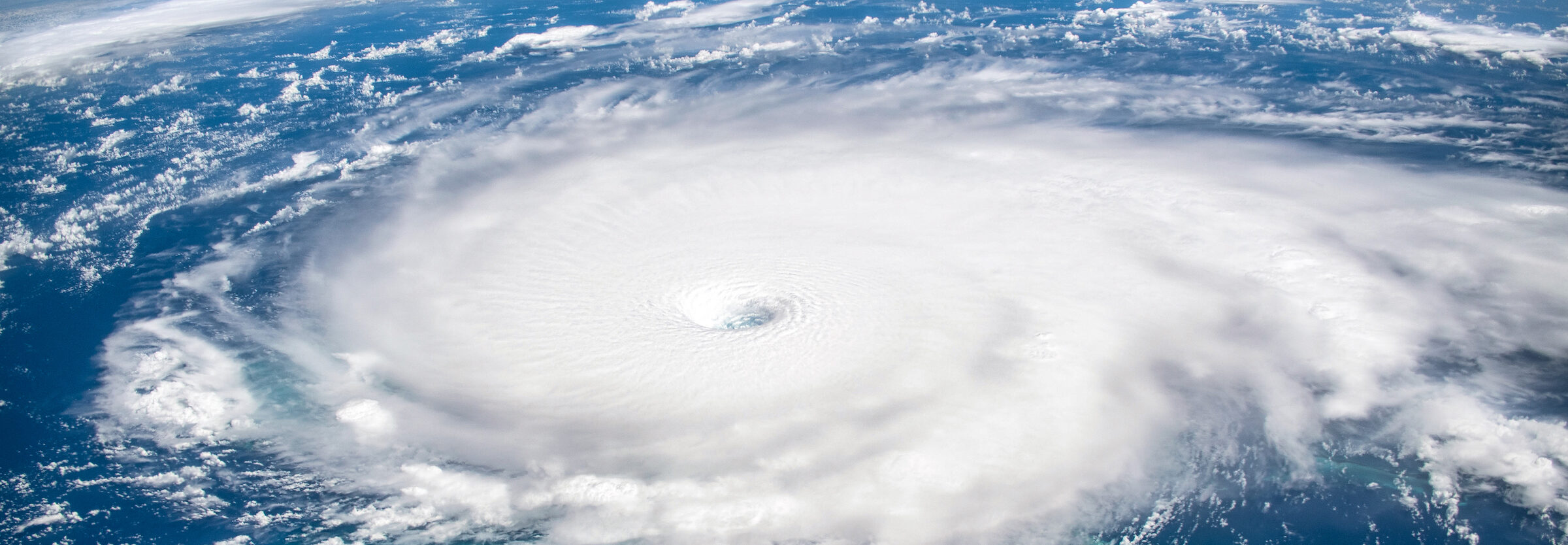
Be ready for hurricane season. Today you can determine your personal hurricane risk, find out if you live in a hurricane evacuation zone, and review/update insurance policies. You can also make a list of items to replenish hurricane emergency supplies and start thinking about how you will prepare your home for the coming hurricane season. If you live in hurricane-prone areas, you are encouraged to complete these simple preparations before hurricane season begins on June 1.
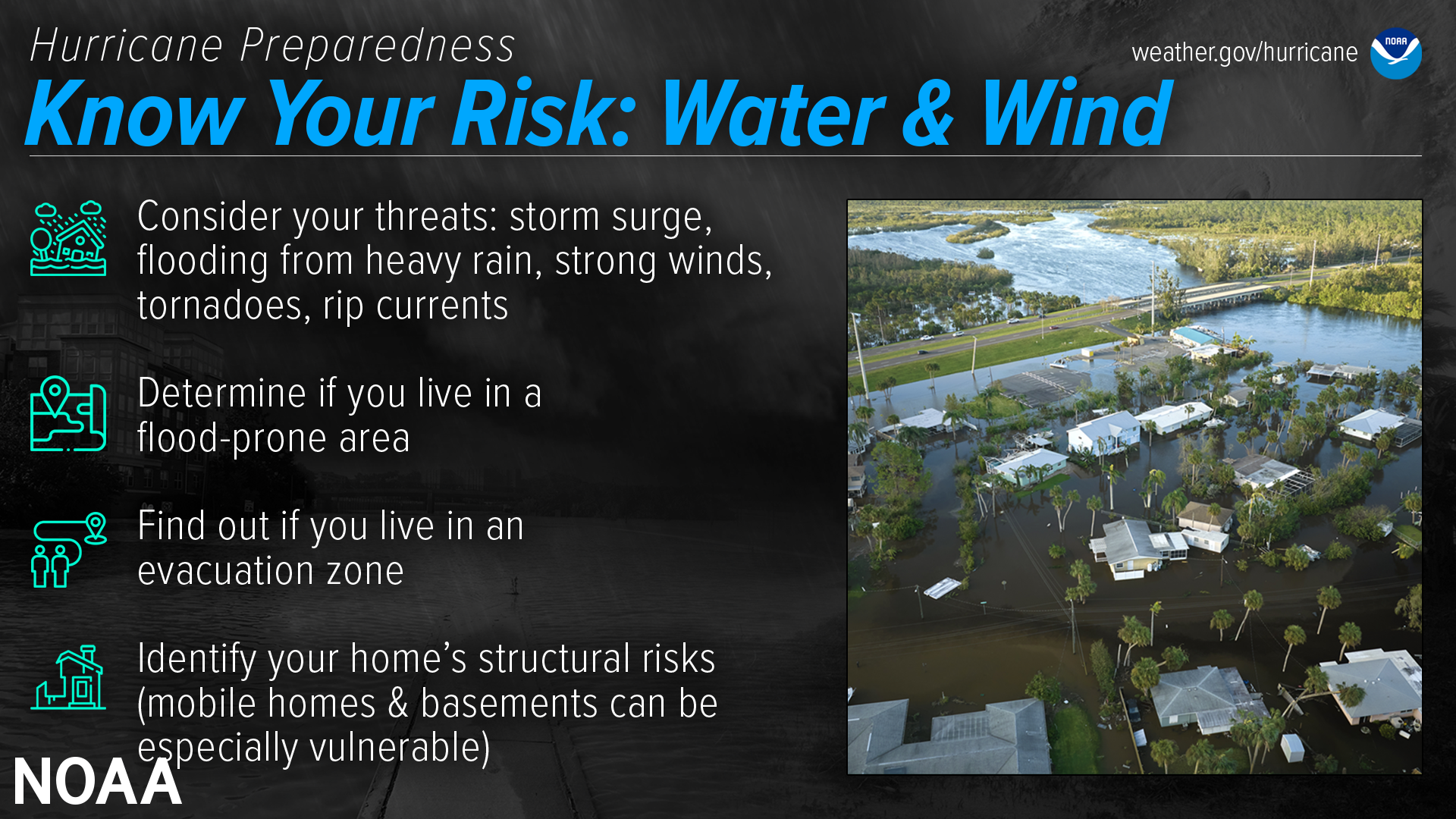
Find out today what types of wind and water hazards could happen where you live. Hurricanes are not just a coastal problem. Impacts from wind and water can be felt hundreds of miles inland, and significant impacts can occur regardless of the storm’s strength. Know if you live in an area prone to flooding, if you live in an evacuation zone, and identify any structural weaknesses in your home.
Consider Your Threats
While hurricanes pose the greatest threat to life and property, tropical storms and tropical depressions also can be devastating. The primary hazards from tropical cyclones (which include tropical depressions, tropical storms, and hurricanes) are storm surge flooding, inland flooding from heavy rains, destructive winds, tornadoes, and high surf and rip currents.
Determine if you live in a flood-prone area
Anyone living in a flood-prone area is especially vulnerable to hurricane impacts. Find out today the flood risk for your area and plan accordingly. If you don’t live in a flood zone, that doesn’t necessarily mean you’re safe – extreme rain from hurricanes can bring floods even to areas that aren’t prone to flooding.
Find out if you live in an evacuation zone
Determine if you live in a storm surge evacuation zone. This can tell you about your vulnerability to storm surge, and will be imperative when it comes time to develop an evacuation plan.
Identify your home’s structural risks
Find out if your home has any weaknesses that could prove deadly in a hurricane. Are your exterior doors and garage door hurricane proof? Do you have storm shutters? Some aspects of your home can be strengthened to help withstand hurricane impacts, and some can not. Mobile homes are especially vulnerable to hurricane-force winds, and basements are especially vulnerable to storm surge and flooding.
Additional Resources:
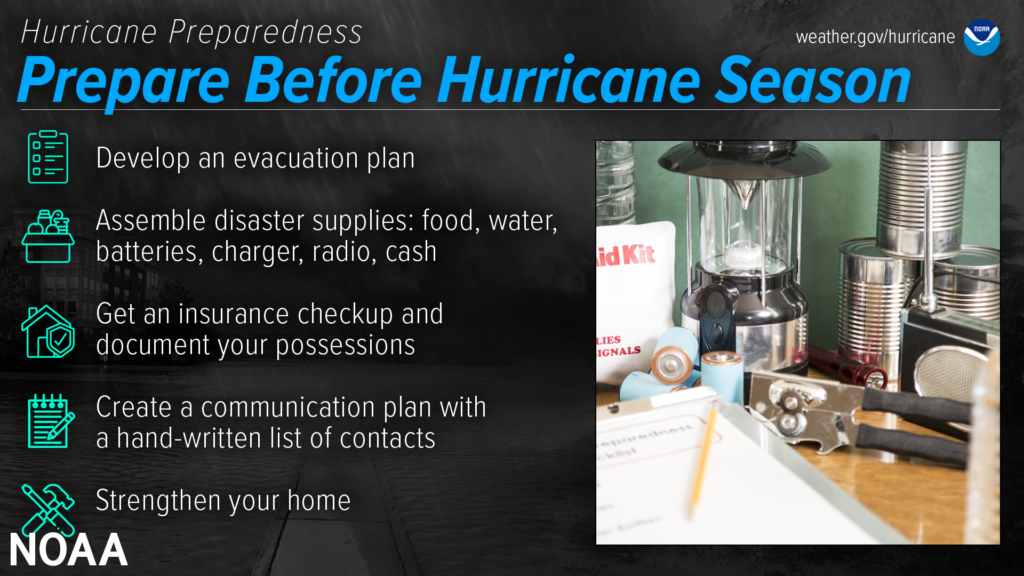
The best time to prepare is before hurricane season begins. Avoid having to rush through potentially life-saving preparations by waiting until it’s too late. Get your disaster supplies while the shelves are still stocked, and get that insurance checkup early, as flood insurance requires a 30-day waiting period.
Develop an evacuation plan
If you are at risk from hurricane impacts, you need an evacuation plan. Now is the time to begin planning where you would go and how you would get there. You do not need to travel hundreds of miles. Your destination could be a friend or relative who lives in a well built home outside flood prone areas. Plan several routes. Be sure to account for your pets.
If you don’t have a vehicle, check with local officials to see what transportation options they may have available.
Assemble disaster supplies
Whether you’re evacuating or sheltering-in-place, you’re going to need supplies not just to get through the storm but for the potentially lengthy and unpleasant aftermath. Have enough non-perishable food, water and medicine to last each person in your family a minimum of 3 days (store a longer than 3-day supply of water, if possible). Electricity and water could be out for weeks. You’ll need extra cash, a battery-powered radio and flashlights. You may need a portable crank or solar-powered USB charger for your cell phones. And lastly, don’t forget your pets!
Get an insurance checkup & document your possessions
Call your insurance company or agent and ask for an insurance check-up to make sure you have enough insurance to repair or even replace your home and/or belongings. Remember, home and renters insurance doesn’t cover flooding, so you’ll need a separate policy for it. Flood insurance is available through your company, agent, or the National Flood Insurance Program at floodsmart.gov. Act now, as flood insurance requires a 30-day waiting period.
Take the time before hurricane season begins to document your possessions: photos, serial numbers, or anything else that you may need to provide your insurance company when filing a claim.
Create a communication plan
Take the time now to write down your hurricane plan, and share it with your family. Determine family meeting places, and make sure to include an out-of-town location in case of evacuation. Write down on paper a list of emergency contacts, and make sure to include utilities and other critical services — remember, the internet may not be accessible during or after a storm.
Strengthen Your Home
Now is the time to improve your home’s ability to withstand hurricane impacts. Trim trees. Install storm shutters, accordion shutters, and/or impact glass. Seal outside wall openings. Remember, the garage door is the most vulnerable part of the home, so it must be able to withstand hurricane-force winds. Many retrofits are not as costly or time consuming as you may think. If you’re a renter, work with your landlord now to prepare for a storm.
And remember – now is the time to purchase the proper plywood, steel or aluminum panels to have on hand if you need to board up the windows and doors ahead of an approaching storm.
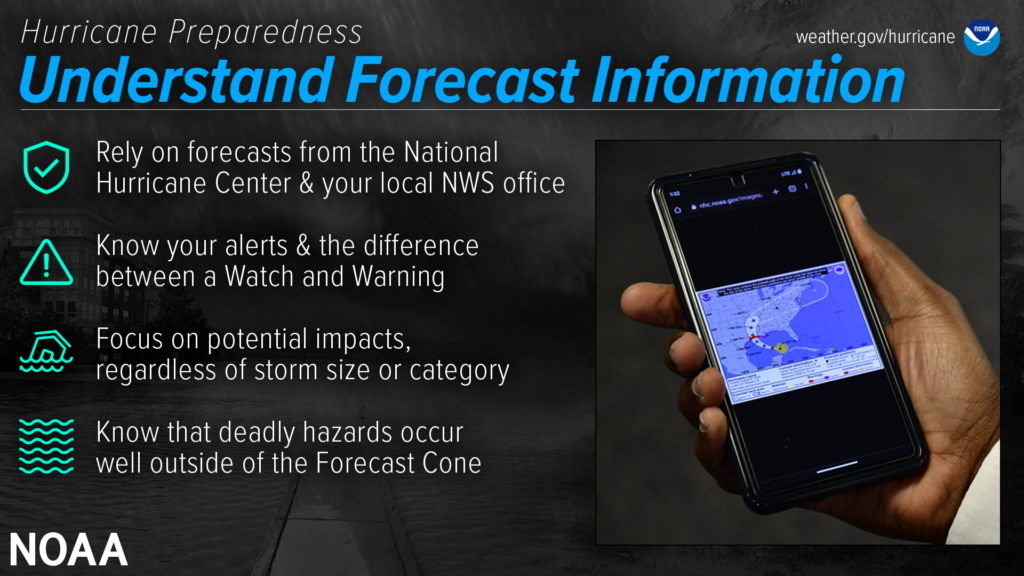
Focus on potential impacts regardless of storm size or category
Do not focus on a specific storm category; all hurricanes and tropical storms can bring life-threatening storm surge, inland flooding, and damaging winds. The storm’s scale only tells you about the strongest winds near the center of the storm and does not tell you about potentially life-threatening flooding from storm surge or rain. Remain vigilant even if the winds have weakened and the storm becomes a lower category or tropical storm — rainfall and storm surge impacts often continue.
Deadly hazards occur well outside of the cone
Impacts can be felt far from the storm’s center, even well inland and outside the Forecast Cone. Remember: the storm itself can stretch well beyond the Forecast Cone, and so can the impacts.
The National Hurricane Center Forecast Cone shows the probable forecast track of the center of the storm. This means that the storm’s center will probably travel somewhere within the cone’s boundaries. (Historically, the storm’s center has remained within the forecasted cone roughly two-thirds of the time.) The cone does NOT represent the size of the storm in any way.
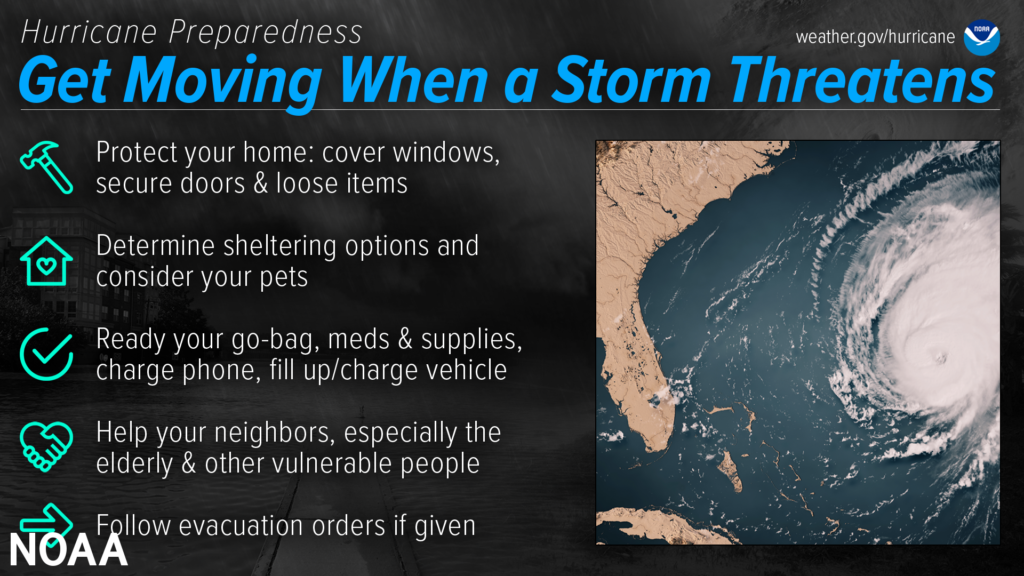
Determine sheltering options & consider your pets
Check with local officials to find out what shelter spaces are available. If you have pets, find a place where they can stay — most public shelters only allow service animals. In general, have multiple sheltering options, including distant ones such as a friend’s home outside of the impact area, or a motel. Depending on the circumstances, your home may need to be your shelter — make sure it is prepared and that you know the safest places inside.
Ready your go-bag, meds & supplies, charge phone, fill up/charge vehicle
Have a go bag ready to take things with you if you need to leave in a hurry. In addition to basic survival needs, don’t forget other supplies such as chargers and hygiene products. Plan to have enough for at least three days, and don’t forget about your pets. While preparing these basic needs, don’t forget to keep your phone charged, and make sure to fill up/charge your vehicle as well.
Your go-bag should also contain important personal and property documents, including your written communication plan.
Help your neighbors, especially the elderly & other vulnerable people
Many people rely on their neighbors before and after a disaster, and there are many ways you can help them. Help them prepare for a storm, and help them evacuate if needed. Share the latest forecast information with your community so that they know what to expect.
Follow evacuation orders if given
Always follow evacuation orders from local authorities — don’t wait for a hurricane to intensify before deciding to follow the order. You want to leave early enough to avoid being trapped by severe weather. If time allows, unplug electrical equipment, leave a note detailing your whereabouts, and check to see if any neighbors need a ride.
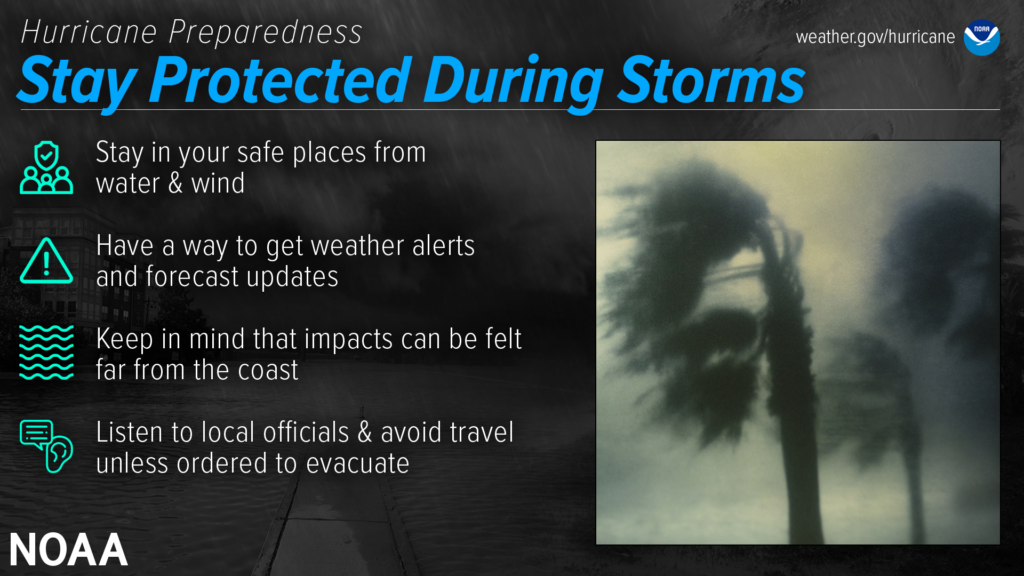
During a storm, whether you’ve evacuated or are sheltering in place, know what to expect from the hazards you may face. Remain vigilant, stay up-to-date with the latest forecasts and alerts, and continue to listen to local officials.
Stay in your safe places from water & wind
Always keep a safe distance from flooded and damaged areas. When you’re at risk from storm surge or flooding, it’s important to get to high ground away from bodies of water and any flood-prone areas. Evacuate if told to do so. Never drive through floodwaters or compromised bridges. Always pay attention to barriers and signage.
If your house becomes flooded and you’re still there, get higher in your house to escape the flood waters. If the highest floor of your home becomes dangerous, get on the roof and call 911.
Though rain and storm surge cause more direct deaths, wind can also be very destructive and deadly in hurricanes. Winds can be stronger higher above ground level. This can put high-rise buildings at a greater risk. To protect yourself from wind, the best thing you can do is put as many walls as possible between you and the outside. An interior room without windows is the safest place you can be in a building. You can cover yourself with a mattress and wear a helmet for added protection. If your area is under an Extreme Wind Warning, take shelter immediately. Make sure to stay sheltered until the threat is gone.
Have a way to get weather alerts and forecast updates
Make sure to have Wireless Emergency Alerts enabled on your phone to receive Warnings and other alerts. Always pay attention to the latest forecast as conditions can change quickly and storms can rapidly intensify from a tropical storm to a major hurricane. Even small changes in the storm’s track can make a big difference.
Keep in mind that impacts can be felt far from the coast
Remain vigilant even if you’re far from the most damaging winds. Inland flooding can be felt hundreds of miles from the coast. Never drive through floodwaters! A car can be swept away with only a foot of water, and there’s no way to know if the road itself has collapsed when hidden by water.
Listen to local officials & avoid travel unless ordered to evacuate
Local officials can provide you with up-to-date information as the situation changes in your area. Evacuation orders may still be given at this late stage — leave immediately if ordered! Follow recommended evacuation routes — do not take shortcuts, as they may be blocked. Be alert for road hazards such as washed-out roads or bridges and downed power lines. Never drive through floodwaters.
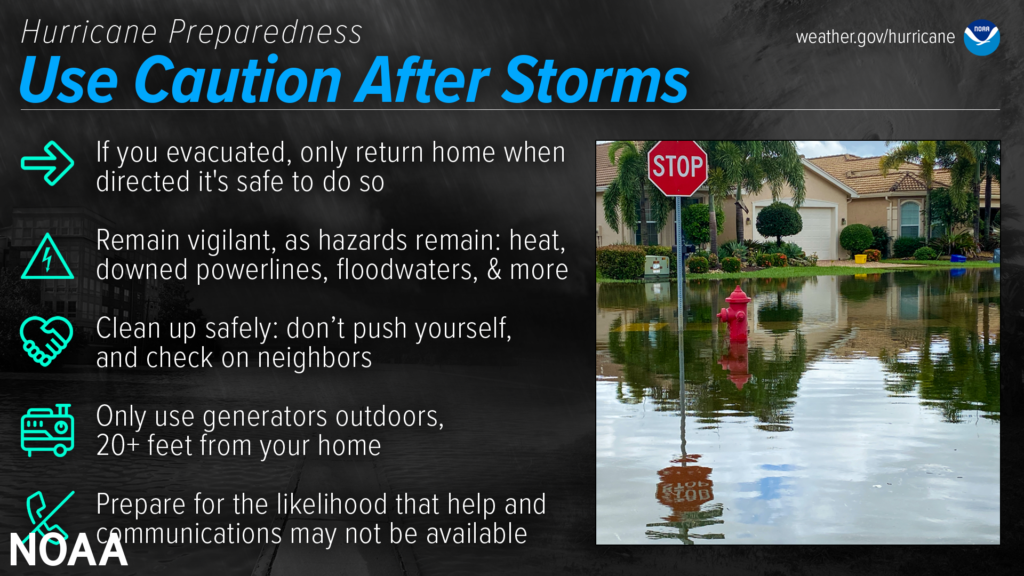
Dangers remain even after the skies turn blue. This is NOT the time to put your guard down. Nearly half of hurricane fatalities occur after the storm.
If you evacuated, only return home only when told to do so
Return home ONLY when officials say it is safe. Check with local officials both where you’re staying and back home before you travel.
Remain vigilant, as hazards remain
Clean up safely: don’t push yourself, and check on neighbors
Stay hydrated, wear light, loose-fitting clothing, and clean up during cooler hours if possible. Don’t push yourself: straining the body can lead to heart attacks, heat strokes, and other serious issues. Perform cleanups slowly, taking lots of breaks. Make sure to check on your elderly neighbors and other vulnerable people in your community. If your area is under a Heat Advisory, use extreme caution and consider cleaning up when the heat has subsided.
Practice portable generator safety
Be very careful with portable generators: carbon monoxide poisoning is one of the leading causes of death in areas dealing with power outages. Never use a generator inside your home or garage, even if doors and windows are open. Only use generators outside, more than 20 feet away from your home, doors, and windows.
Help and communications may not be readily available
After a hurricane, emergency responders may be overwhelmed. Be aware that it could take hours or days for them to reach your area. Communication systems may be impacted, and making phone or video calls might be difficult due to network congestion. If possible, communicate via text, email, or social media.
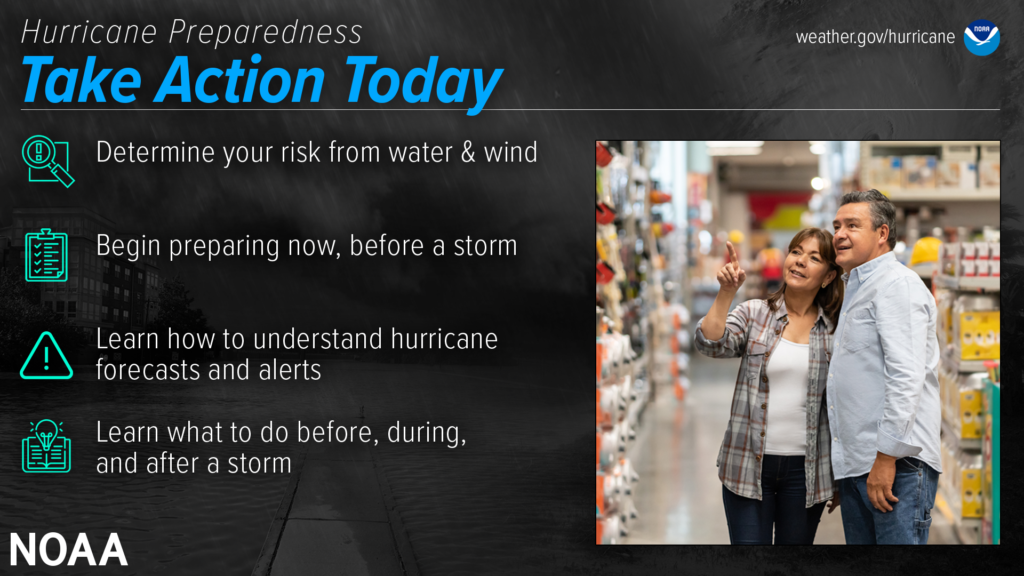
Are you ready for hurricane season? Take action TODAY to be better prepared for when the worst happens. Understand your risk from hurricanes, and begin pre-season preparations now. Make sure you understand how to interpret forecasts and alerts, and know what to do before, during, and after a storm. Even if you are already well-prepared and knowledgeable, there may be additional things you could do or learn to be even more prepared.
Bilma PUD will began flushing of the District’s water distribution system beginning on Monday, May 15th and is expected to be completed by Friday, May 26th. Annual flushing of the District’s water system is a requirement of the TCEQ and maintains the water quality you are used to. If you experience any discolored water in your home, please flush your houseline for approximately 10 minutes and the problem should clear up. If you continue to have any issues, please contact our office at 281-353-9809 and we can send a service technician to assist you.